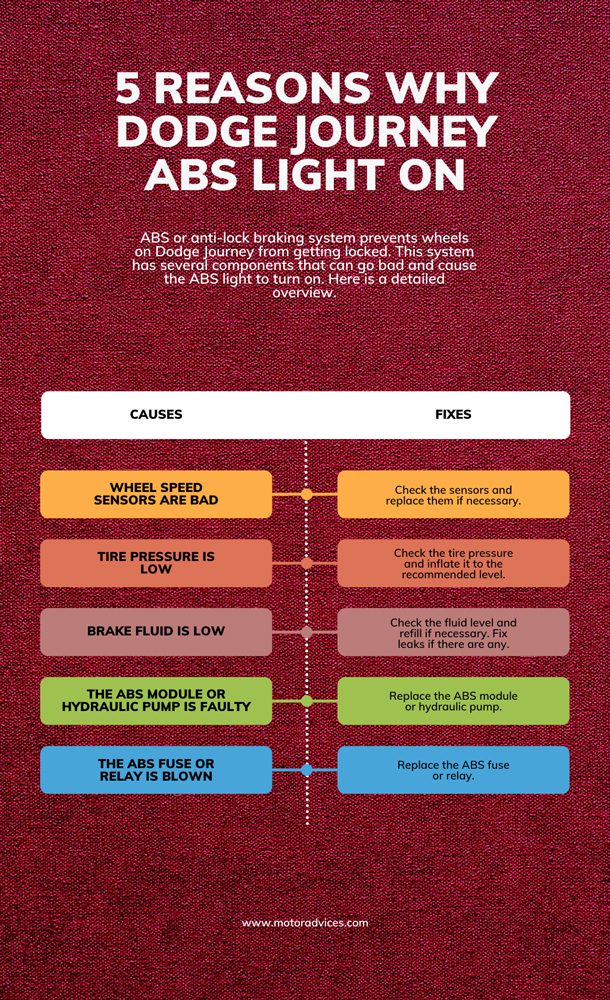Dodge Journey ABS Light On: Common Causes and Resetting Solutions
As a crossover SUV, Dodge Journey has a decent number of safety features, including the ABS. It helps the vehicle come to a safe stop at a high speed. But sometimes, the ABS light can come up on the dashboard.
So, why is the Dodge Journey ABS light on? And how to reset the ABS light? The ABS light on your Dodge Journey can illuminate if
- Wheel speed sensors are bad
- Tire pressure is low
- Brake fluid is low
- The ABS module or hydraulic pump is faulty
- The ABS fuse or relay is blown
In this guide, I will show you how to diagnose the cause and reset the ABS light. Let’s get started.
Dodge Journey ABS Light On: Quick Fixes

Check the following chart of quick solutions before getting into more detail.
| Causes | Fixes |
|---|---|
| Wheel speed sensors are bad | Check the sensors and replace them if necessary. |
| Tire pressure is low | Check the tire pressure and inflate it to the recommended level. |
| Brake fluid is low | Check the fluid level and refill if necessary. Fix leaks if there are any. |
| The ABS module or hydraulic pump is faulty | Replace the ABS module or hydraulic pump. |
| The ABS fuse or relay is blown | Replace the ABS fuse or relay. |
5 Reasons Why Dodge Journey ABS Light On
ABS or anti-lock braking system prevents wheels on Dodge Journey from getting locked. This system has several components that can go bad and cause the ABS light to turn on. Here is a detailed overview.

1. Wheel Speed Sensors Are Bad
As you might assume from the name, wheel speed sensors measure the rotational speed of all wheels. They are fitted to each wheel to determine how fast the vehicle is going and when to apply or release the brake automatically.
These sensors send speed data to the control module, which then processes the data and performs braking operations. As these sensors are exposed to harsh conditions, such as dust, metal debris, etc., these sensors can’t work properly.
If the Dodge Journey ABS sensor is bad, the control module won’t receive speed information. As a result, the ABS won’t be able to work and the ABS light will come up on the dashboard.

How to Fix It?
- First of all, you need to use an OBDII scanner to detect the reason.
- Plug the scanner into the OBDII port under the dashboard and read the error codes.
- If the code indicates a problem with wheel speed sensors, you need to replace them.
- When you need to replace all four sensors, it might cost about $150 for parts and another $150 for labor.
2. Tire Pressure Is Low
All tires of your Dodge Journey should have a certain amount of air pressure. If the tires are underinflated, their radius gets reduced. Due to the reduced radius of the wheels, it seems like the tires are rotating faster than they would normally. And it affects the reading on wheel speed sensors.
As a result, different wheels can send varying speed information to the control module. This causes the ABS to fail and the ABS light turns on to indicate the fault.

How to Fix It?
- If you have a TPMS or tire pressure monitoring system on your Dodge Journey, you can easily check the air pressure in individual tires.
- But if you don’t have the device installed, you need to manually check the tire pressure.
- Take a pressure gauge and check the air pressure in all four tires.
- If you find any tire underinflated, inflate it until the air pressure reaches 36 psi. It is the recommended tire pressure for Dodge Journey.
- Do this for all underinflated tires.
3. Brake Fluid Is Low
Cars have brake fluid reservoirs that should be filled to the mark. When you press the brake pedal, the brake fluid travels to the brake cylinder and causes the calipers to press onto the brake disc.
But if the fluid level is low, it can’t build up pressure inside the cylinder. As a result, the braking performance of the vehicle won’t be as expected.
If the ABS module senses any shortage in the brake fluid, it will stop working. So, the ABS light will turn on.

How to Fix It?
- The first step is to check the brake fluid level. Open the brake fluid reservoir cap and check the fluid level.
- If the fluid level is low, top it up with new fluid. Make sure the fluid level reaches the high mark.
- A drastic change in fluid level means there might be leaks in the reservoir. So, get the fluid reservoir checked by a mechanic. If there are any leaks, get them repaired.
4. The ABS Module or Hydraulic Pump Is Faulty
The Anti-Lock Braking System consists of multiple components. Some of these components are electronic and others are mechanical. Hydraulics is used to move the mechanical parts. For example, the control module commands the actuator to open or close the valve depending on the wheel speed conditions.
If the module fails to send the right command, the ABS won’t work. Water damage and physical damage are common reasons behind ABS module failure. Dirt and grime can also cause the module to fail.
Sometimes, the hydraulic pump can also be faulty. In such cases, the ABS light will come up on the dashboard.

How to Fix It?
- You may not be able to identify a faulty control module or hydraulic pump through visual inspection. So, you need an OBDII scanner to find the problem.
- Connect the scanner and check the error code.
- If the control module or hydraulic pump is faulty, get them replaced. It may cost about $900 for parts and $300 for labor.
5. The ABS Fuse or Relay Is Blown
Two fuses and a relay work in combination to keep the ABS functioning. If the first fuse is blown, the electricity won’t reach the relay. And if the relay is bad, the second fuse won’t get the power. Any fault in these fuses or relays can cause the ABS to stop working.
And you will see the ABS light turn on. Brake lights may not be illuminated in this case and you can brake normally.

How to Fix It?
- Replacing the blown fuse or relay is the only solution here.
- Get the fuses and relays checked by a professional mechanic and replace the necessary parts.
- It may cost about $200 for parts and labor.
How to Reset Dodge Journey ABS Light?

Once you have fixed the cause, the ABS light should turn off automatically. But sometimes, the ABS light won’t go out on its own. In that case, you need to reset the light manually. Check the following steps to reset the Dodge Journey ABS light.
- Step 1: Take an OBDII scanner and connect it to the OBDII port of the vehicle.
- Step 2: Make sure all the problems are fixed before resetting the light.
- Step 3: Go to options and find the Clear Codes option.
- Step 4: Select the Clear Codes option and confirm.
All codes will now be reset and the ABS light will turn off.
Experiencing ABS light issues isn’t unique to the Dodge Journey; other cars have their share of challenges in this department. For Subaru enthusiasts or owners, the Legacy and Impreza models sometimes present ABS light concerns. If you’re curious or ever find yourself in a situation with a Subaru, our guide on why the Subaru Legacy might have its ABS light on can be immensely helpful. Similarly, our article dedicated to Subaru Impreza ABS light issues delves into the potential causes and solutions for this model.FAQs
Check answers to some commonly asked questions about Dodge Journey ABS light on.
Yes. As long as the normal braking system works perfectly, it is safe to drive the car even if the ABS light is on. But driving at high speed with the ABS light on can be risky.
Yes. Besides ABS malfunctioning, low tire pressure can cause the traction control system to stop working. So, you will see the traction control light come on.
It is unlikely for the ABS to cause brake failure. But sometimes, brake pedals can be hard to push if the ABS is bad.
Conclusion
Modern vehicles have smart diagnostic systems that can detect problems in different components. The ABS light on the dashboard means the ABS isn’t working at this moment. To turn off the light, you should find out the cause and fix it.
So, why is the Dodge Journey ABS light on? It can be turned on if the tire pressure is low, the ABS module is bad, the ABS fuse is blown, or the sensors go bad. I provided detailed solutions with simple steps so that you can fix these problems. If you don’t have experience with a critical component, DIY fixing can cause more problems. So, call for professional help.

